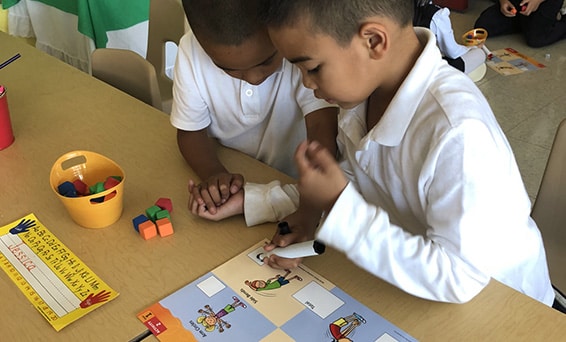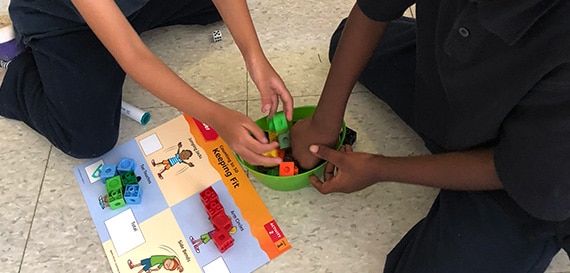Teacher uses Mathology to help students meet expectations, gain math confidence, and more
By Wendy McMahon
“Mrs. Drotos, I did it!” Those words are music to Christine Droto's ears during a math lesson. And she hears them from her grade one students increasingly often since her school, St. Lawrence Catholic School, adopted Pearson’s Mathology program.
A teacher for 22 years, Drotos was searching for a program that provided more support for math instruction than past tools. She wanted support for differentiation, assessment, and hands-on learning—along with tools to help grow students’ math vocabulary and build confidence in their math skills.
“As soon as I saw the Mathology program, I thought ‘this meets so many of our requirements and supports what we’re being asked to do in terms of how we teach math and how we think about math now.’ It just kept ticking off all the boxes,” explains Drotos.
“Mathology is grounded in research. You can tell Pearson spent the time working with kids, teachers, and educators and working with the research knowledge that’s out there about what we know about math and how to teach math.”
Christine Drotos
Support for assessment and differentiation
Moving more students from a level two to level three (the expectation for grade one student achievement in math) was a major goal for Drotos’s district. And Mathology’s assessment and differentiation tools supported her in working toward this goal in her classroom.

“Mathology’s assessment sheets—which include suggestions for what to do if a student doesn’t understand a concept as well as differentiation options—helped me identify quickly who my level two children were,” explains Drotos. “And the suggestions for next steps really helped me move them forward to that level three mark and, for some, even beyond.
“With the assessment tools, I knew exactly what to look for and what next steps to take. It was easy, and it was right there in front of me on the sheet as I walked around—‘if the child is doing this, then here’s your strategy to either help them understand or bring them even further along.'”
Using the assessment tools also helped Drotos easily and quickly pinpoint where students were on the Mathology Learning Progression.
“I can’t think of a day this year since I started to use Mathology that I really sat them down to do a pencil and paper task.”
Christine Drotos
Growing math vocabulary
Another goal for teachers at Drotos’s school was improving students’ use and understanding of math vocabulary. With the help of Mathology’s Little Books and vocabulary suggestions included in lessons and activities, students were encouraged to use math language and explain their thinking.
Initially, Drotos says it was difficult for students to explain how they came up with an answer to a math question. But with practice, it became second nature.
“These kids are a lot more confident in terms of their knowledge of math. They love math a lot more than they might have before because they’re involved and doing activities.”
Christine Drotos

“It was just expected that they would talk about not only the answer but what they did to get their answer,” explains Drotos. “They would say, ‘I know, you’re going to ask me what my brain did to figure that out.’ And they started understanding that even if their answer wasn’t correct, that was OK because this was their way of thinking about it.”
“It really de-escalated their worries around always needing to have the right answer in math. For those who weren’t confident in their math capability, it gave them the opportunity to still answer and share how they did something without worrying about being wrong. I liked that a lot.”
“It really de-escalated their worries around always needing to have the right answer in math. For those who weren’t confident in their math capability, it gave them the opportunity to still answer and share how they did something without worrying about being wrong. I liked that a lot.”
Christine Drotos
Hands-on learning
With a school-wide goal to bring more hands-on learning to her math lessons, Drotos says one of her favourite aspects of the Mathology program is the activities.
“I can’t think of a day this year since I started to use Mathology that I really sat them down to do a pencil and paper task. And of the times that that happened (if there was a substitute teacher), they were not happy,” laughs Drotos.
“The kids were so engaged. And that engagement was truly sustained for the whole duration of the activity period. The Mathology activities never failed. That says a lot about the age appropriateness of the activities, they always hit the mark.”
Going forward
At the end of the school year, Drotos says students approached math differently. “I noticed a big difference in terms of their ability of how they thought about math, the math language they used, and their whole thinking process,” she explains.
“I was looking for a program that was very hands-on and relatable for students and that’s what I found in Mathology.”
Christine Drotos
“These kids are a lot more confident in terms of their knowledge of math. They love math a lot more than they might have before because they’re involved and doing activities.”
Drotos says she’ll continue to use Mathology to support her students because it’s such an effective program. Her district, Toronto Catholic District School Board, which rolled out a Mathology pilot program to grade one classes in 20 elementary schools during the 2017/2018 school year is also planning to expand the program to include grade two classrooms in the 2018/2019 school year.


